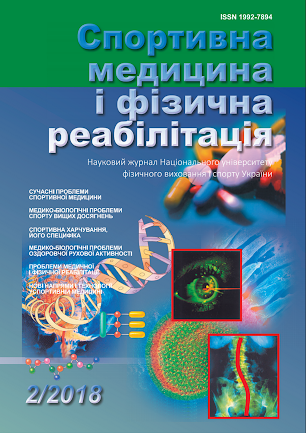Аналіз сучасних шкал для оцінки рівня активності та участі осіб з хребтово-спинномозковою травмою
Основний зміст сторінки статті
Анотація
Блок інформації про статтю

Ця робота ліцензується відповідно до Creative Commons Attribution 4.0 International License.
Журнал практикує політику негайного відкритого доступу до опублікованого змісту, підтримуючи принципи вільного поширення наукової інформації та глобального обміну знаннями задля загального суспільного прогресу.
Редакційна колегія дотримується рекомендацій The Committee on Publication Ethics (COPE) з питань этики наукових публікацій.
ОБОВ'ЯЗКОВЕ ПОСИЛАННЯ НА АВТОРІВ ПРИ КОПІЮВАННІ ЧИ ЦИТУВАННІ МАТЕРІАЛУ НАУКОВИХ СТАТЕЙ
Автори, які публікуються у цьому журналі, погоджуються з наступними умовами:
- Автори залишають за собою право на авторство своєї роботи та передають журналу право першої публікації цієї роботи на умовах ліцензії Creative Commons Attribution License, котра дозволяє іншим особам вільно розповсюджувати опубліковану роботу з обов'язковим посиланням на авторів оригінальної роботи та першу публікацію роботи у цьому журналі.
- Автори мають право укладати самостійні додаткові угоди щодо неексклюзивного розповсюдження роботи у тому вигляді, в якому вона була опублікована цим журналом (наприклад, розміщувати роботу в електронному сховищі установи або публікувати у складі монографії), за умови збереження посилання на першу публікацію роботи у цьому журналі.
- Політика журналу дозволяє і заохочує розміщення авторами в мережі Інтернет (наприклад, у сховищах установ або на особистих веб-сайтах) рукопису роботи, як до подання цього рукопису до редакції, так і під час його редакційного опрацювання, оскільки це сприяє виникненню продуктивної наукової дискусії та позитивно позначається на оперативності та динаміці цитування опублікованої роботи (див. The Effect of Open Access).
Посилання
Abedzadeh-Kalahroudi, M., Razi, E., Sehat, M., Asadi-Lari, M. (2016 May). Psychometric properties of the world health organization disability assessment schedule II-12 Item (WHODAS II) in trauma patients. Injury, 47(5), 1104-1108.
Alexander, M.S., Anderson, K.D., Biering-Sorensen, F., Blight, A.R., Brannon, R., Bryce, T.N., et al. (2009 Aug). Outcome measures in spinal cord injury: recent assessments and recommendations for future directions. Spinal Cord, 47(8), 582-591.
Anderson, K., Aito, S., Atkins, M., Biering-Sorensen, F., Charlifue, S., Curt, A., et al. (2008). Functional recovery measures for spinal cord injury: an evidence-based review for clinical practice and research. The journal of spinal cord medicine, 31(2), 133-144.
Bluvshtein, V., Front, L., Itzkovich, M., Aidinoff, E., Gelernter, I., Hart, J., et al. (2011 Feb). SCIM III is reliable and valid in a separate analysis for traumatic spinal cord lesions. Spinal Cord, 49(2), 292-296.
Burns, A.S., Marino, R.J., Flanders, A.E., Flett, H. (2012). Clinical diagnosis and prognosis following spinal cord injury. Handb. Clin. Neurol., 109, 47-62.
Catz, A.L., Itzkovich, M., Tesio, L., Biering-Sorensen, F., Weeks, C., Laramee, M.T., et al. (2007 Apr). A multicenter international study on the Spinal Cord Independence Measure, version III: Rasch psychometric validation. Spinal Cord, 45(4), 275-291.
Federici, S., Bracalenti, M., Meloni, F., Luciano, J.V. (2016). World Health Organization Disability Assessment Schedule 2.0: An International Systematic Review. Disability and Rehabilitation, 39(23), 2347-2380.
Fehlings, M.G., Vaccaro, A.R., Boakye, M. (2012). Essentials of Spinal Cord Injury: Basic Research to Clinical Practice. Thieme, 682 p.
Furlan, J., Noonan, V., Singh, A., Fehlings, M. (2011). Assessment of disability in patients with acute traumatic spinal cord injury: a systematic review of the literature. J. Neurotrauma, 28, 1413-1430.
Gresham, G.E., Labi, M.L., Dittmar, S.S., Hicks, J.T., Joyce, S.Z., Stehlik, M.A. (1986 Feb). The Quadriplegia Index of Function (QIF): sensitivity and reliability demonstrated in a study of thirty quadriplegic patients. Paraplegia, 24(1), 38-44.
Hagen, E.M., Rekand, T., Gilhus, N.E., Gronning, M. (2012). Traumatic spinal cord injuries – incidence, mechanisms and course. Tidsskr Nor Legeforen, 132, 831.
Harvey, L.A. (2008). Management of Spinal Cord Injuries: A Guide for Physiotherapists. Elsevier Health Sciences, 297 p.
Harvey, L.A., Anderson, K.D. (2015 Apr). The spinal cord independence measure. J. of Physiotherapy, 61(2), 99.
Holtz, A., Levi, R. (2010). Spinal Cord Injury. Oxford University Press, 336 p.
Itzkovich, M., Gelernter, I., Biering-Sorensen, F., Weeks, C., Laramee, M.T., Craven, B.C., et al. (2007 Dec 30). The Spinal Cord Independence Measure (SCIM) version III: reliability and validity in a multicenter international study. Disability and Rehabilitation, 29(24), 1926-1933.
Kirshblum, S.C., Biering-Sorensen, F., Betz, R., Burns, S., Donovan, W., Graves, D.E., et al. (2014 March). International Standards for Neurological Classification of Spinal Cord Injury: Cases with classification challenges. J. of Rehabilitation Medicine, 37(2), 120-127.
Kirshblum, S.C., Burns, S.P., Biering-Sorensen, F., Donovan, W., Graves, D.E., Jha, A. (2011 Nov). International standards for neurological classification of spinal cord injury (Revised 2011). J. Spinal Cord Med, 34(6), 535-546.
Kuo, C.Y., Liou, T.H., Chang, K.H., Chi, W.C., Escorpizo, R., Yen, C.F. (2015). Functioning and disability analysis of patients with traumatic brain injury and spinal cord injury by using the world health organization disability assessment schedule 2.0. Int. J. Environ. Res. Public Health, 12(4), 4116-4127.
Marino, R.J. (2007). Domains of outcomes in spinal cord injury for clinical trials to improve neurological function. J. of Rehabilitation Research & Development, 44(1), 113-122.
Nitsch, K.P, Stipp, K.L. (2016). Measurement Characteristics and Clinical Utility of the Spinal Cord Independence Measure-III Among Individuals With Spinal Cord Injury. Archives of Physical Medicine and Rehabilitation, 97, 1601-1603.
Radomski, M.V., Trombly, C.A. (2013). Occupational Therapy for Physical Dysfunction. 7th ed. LWW; Seventh, North American, 1536 p.
Weidner, N., Rupp, R., Tansey, K.E. (2017). Neurological Aspects of Spinal Cord Injury. Springer, 770 p.
Wolf, A.C., Tate, R.L., Lannin, N.A., Middleton, J., Lane-Brown, A., Cameron, I.D. (2012). The World health organization Disability Assessment Schedule II, WHODAS II: reliability and validity in the measurement of activity and participation in a spinal cord injury population. J. of Rehabilitation Medicine, 44, 47-755.
